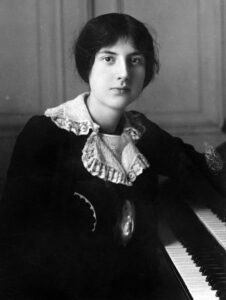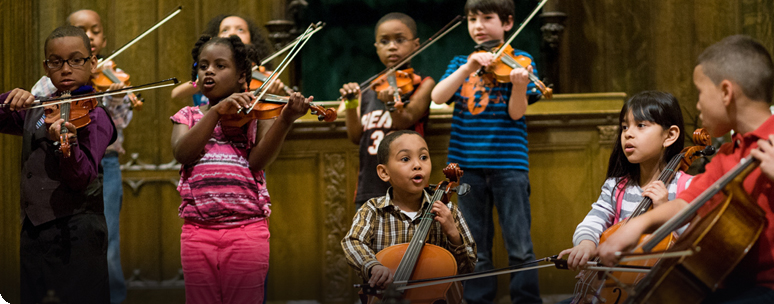
December’s Sonata Series event brings you the distinctive sounds of 20th-century French Romantic music. Violin Fellow Kimberly Fang shares Eugène Ysaÿe’s indomitable and soulful Sonata No. 4 for Unaccompanied Violin. Resident Musician Lisa Barksdale and guest pianist Jeffrey Louie present two gems by little known composer Lili Boulanger (sister of the renowned composer and teacher Nadia Boulanger) and Claude Debussy’s final work before his passing, the vibrant and mercurial Sonata for Violin and Piano in G minor.
DIRECT LINK HERE

This hour-long presentation of our Student Performance Party includes musical performances, jokes, and joy. CMW students and teachers have been working hard despite the challenges of online learning. Watch as students perform for family and friends in a virtual community event!
DIRECT LINK HERE

By Jeff Louie
Claude Debussy’s sonata for violin and piano, written in 1916-1917, was the last significant composition he completed. Its premiere, on which he played the piano part himself, was his final public performance. The sonata was the third of what he had intended to be a six-sonata cycle, after the sonata for cello and piano from 1915 (performed a few years ago in the CMW Sonata Series by Zan Berry and Sakiko Mori) and the sonata for flute, viola and harp, also from 1915. Before these sonatas, Debussy had not written any type of chamber music in more than two decades, since his string quartet from 1893. (That string quartet is such a masterpiece that perhaps he felt he had nothing more to add to the chamber music repertoire?)
Debussy is a profoundly significant figure in the history of western classical music. Yet he is broadly embraced and beloved in a way that similarly important composers of the era (e.g. Schoenberg or Stravinsky) often are not. Debussy’s willingness to discover the sounds of other cultures and to break the harmonic conventions of his own—the centuries-old rules about which notes were allowed to go together and how certain sound combinations were supposed to resolve—wasn’t merely about defiance; it was always about finding better and more original ways of evoking emotion through his art. His sensitivity to the feelings that sound combinations could hint at imbues his music with a uniquely visceral appeal.
What happens to a rule-breaking artist once they’ve created their ground-breaking masterpieces—after they’ve broken all the rules? Where do you find inspiration after you’ve scorched the earth? There’s a bit of a pattern for many artists: they often pare down, shed the excesses, and look backwards. After the youthful “Russian phase” of Stravinsky’s career (which included the most incendiary, revolutionary works of his career, including Petroushka and The Rite of Spring), Stravinsky turned to baroque and early classical music for inspiration for his “neoclassical phase,” featuring sparser and more formally rigid music. (An example from another genre—after the extravagances of Sgt. Pepper and the White Album, the Beatles made a conscious effort to “Get Back” to their stripped-down rock and roll roots.)
In Debussy’s case, he was drawn to the great French composers from the past, particularly Rameau and Couperin. The sonatas of Debussy’s late sonata cycle are not the sonata forms of Beethoven and Schubert, but resemble more closely the form of 18th century “monothematic” sonatas. In other words, don’t listen to them waiting for a distinctive second theme to come in establishing a new tonal center and then anticipate its triumphant restatement later in the home key! But, as in all Debussy, do listen to the subtle changes in texture, to the way a snippet of melody is repeated on top of a slightly altered accompaniment, and notice how these details make you feel—how a new harmony can add a dark undertone to a previously insouciant tune, how a small up-and-down gesture in the violin creates an ephemeral sniff of dread. Also, particularly in the violin sonata’s second movement, listen for the sense of mischief—Debussy had a great talent for incorporating playfulness into his music.
Debussy’s plans for the other sonatas in the cycle included one for oboe, horn, and harpsichord, and one for trumpet, clarinet, bassoon, and piano. The sixth and final sonata was to combine all the instruments of all the other sonatas into a concerto grosso type of composition, focusing on all the different sonorities that combination of instruments could produce. Unfortunately he passed before he was able to complete this project. One can only wonder if, had he lived longer, his late-career return to small ensembles would have produced even more masterpieces to the chamber music repertoire.
***
Jeffrey Louie is an accomplished instrumentalist, composer, and arranger across a wide range of musical disciplines. A virtuoso pianist and violinist, he has soloed on both instruments with numerous Boston-area orchestras and has served as principal second violinist for the Yale Symphony and the Boston Philharmonic. As a pianist in Providence, he is a frequent collaborator with Community MusicWorks and with faculty and students at Brown University. He is a BMI Student Composers Award winner, and at Yale received the Wrexham Prize in Music and the Abraham Beechman Cox Prize for music composition. Jeffrey is also a singer/songwriter and guitarist, as well as a versatile arranger and session musician for a diverse roster of ensembles and recording artists. An avid cruciverbalist, he recently had a crossword puzzle published in the Los Angeles Times.
Hear Debussy’s work performed by Jeff Louie and Lisa Barksdale in our YouTube Sonata Series event.

By Lisa Barksdale
In the year 1913, French music reviewer Émile Vuillermoz wrote:
Several months ago, in this column, I warned musicians of the imminence of the ‘Pink Peril:’ events have not hesitated to prove me right. Madamoiselle Lili Boulanger has just triumphed in the last Prix de Rome competition over all its male contestants, and has carried off the Grand Prize with an authority, a speed, and an ease apt to seriously disturb the candidates who, for long years, cried tears and sweated blood while laboriously approaching this goal. Do not be fooled: this deed stands on its own merits. Not only did the gallantry of the judges not intervene to facilitate her victory, but it could be said that they were stricter with this young girl of nineteen than with her competition. The misogyny of the jury was known. […] And it required all the crushing weight and indisputable authority of this woman’s work to triumph over the student’s homework that surrounded it.”
It’s a statement that reveals a lot about the musical world surrounding Lili Boulanger, about her talent, and about the immensity of her accomplishment in shattering the glass ceiling of the prestigious Prix de Rome prize for composition. It also reveals something significant about what was required of her in order to do it – to write something that was indisputably, beyond the shadow of a doubt, worlds better than all her competitors, so that no juror could be accused of the sin of “gallantry.”
While Mr. Vuillermoz’s statement implies that she triumphed with “ease,” Lili’s path to victory was not without struggle, and sadly a close examination of her life inevitably leads me to ask the question I often ask when studying the lives of the women composers of European classical music – What might have been if not for…? Of course, that’s also a question Jeff will be asking about Debussy. Perhaps it’s a question that could be asked about all artists. But when it comes to looking at the lives of women in the story of music, it seems like those “if not fors” too often became insurmountable obstacles. Thank goodness for Lili Boulanger, they were not entirely.
Lili Boulanger was born to a musical family and soon revealed herself to be the definition of a child prodigy. She tagged along with her older sister Nadia Boulanger (whose name has more widespread recognition among musicians, as she became the composition teacher to many composing giants of the 20th century – Google her) for music lessons with composer Gabriel Faure. Lili learned to play several instruments, including piano, violin, and harp. Her composition skills and passion for music were unquestionable, but her health was poor for her entire life, likely due to a chronic battle with what is now known as Crohn’s disease. Because of her poor health and the death of her father early in her life, Lili’s mother encouraged her to pursue a career through which she might be able to support herself, knowing she was unlikely to marry with the severity of her health issues.
In fact, her first attempt at winning the Prix de Rome ended in a collapse that took her out of the competition, making her second attempt at the competition all the more breathtaking. That win earned her a publishing contract, which allowed her to establish a living for herself and to share a handful of compositions until she passed away peacefully (due to her ongoing battle with Crohn’s) at the tragically young age of 24, in 1918.
While Lili’s short life forces us to ask what we lost by her too-soon departure, the music of hers that we do have is well worth immersing ourselves in. Given the constraints of her short life, health challenges, and World War I, what she was able to accomplish in her music is to be deeply admired. She was especially known for her skills at orchestration and her rich harmonic language featured in orchestral and choral works. But even in the two short pieces featured in this Sonata Series performance – Nocturne and Cortège – you get a small taste of her voice and language as a composer. The Nocturne takes clear inspiration from Debussy, setting a contemplative mood, while the Cortège counterbalances with a playful march.
***
Lisa Barksdale, violinist, is a Resident Musician at Community MusicWorks and Program Coordinator for the Daily Orchestra Program. Read her bio on our website.
Find a detailed chronicle of Lili Boulanger’s life, with links to key pieces in her legacy here.
Hear Boulanger’s work performed by Lisa Barksdale and Jeffrey Louis in this CMW Sonata Series event on YouTube.
LISA BARKSDALE, violin
Program Coordinator, Daily Orchestra Program/Resident Musician
Lisa Barksdale, violinist and Daily Orchestra Program Coordinator, has been a member of the CMW team since 2012. Lisa teaches eager young students in both orchestra and individual lessons and coordinates and supports the mentors who volunteer with the DOP. Lisa earned both a Master of Music and Performance Diploma at Boston University under the guidance of violinist Lucia Lin. Prior to that she earned a Bachelor of Music at the University of Wisconsin-Madison, where she studied with violinist Vartan Manoogian. Since joining CMW Lisa has enjoyed the many opportunities she’s had to explore a variety of her musical interests, including playing the Baroque violin with the Providence Baroque Chamber Orchestra. Lisa lives in Providence with her husband Jeff and their beloved adopted dog Jasper.
KIMBERLY FANG, violin
CMW Violin Fellow, 2019-2021
Kimberly Fang, violinist, is a native of Florida and was always curious about what else the world had to offer. Once she got a taste of the transformative power of music as a teen, she was determined to bring that same awe-inspiring experience to the next generation. She graduated from Northwestern University with a Bachelor of Music in violin performance and music education and earned a Masters in Violin from the San Francisco Conservatory of Music. Before coming to CMW, Kimberly lived in Taipei, teaching English and freelancing as an opportunity to learn more about her heritage and to expand her teaching experiences. Working with young children is her passion, and she has taught in many capacities, including privately, in public schools, online, and in all kinds of subjects. In her spare time, she loves to sing and was a part of a collegiate a cappella group, the Northwestern University Treblemakers.
JEFFREY LOUIE, piano
Guest pianist Jeffrey Louie is an accomplished instrumentalist, composer, and arranger across a wide range of musical disciplines. A virtuoso pianist and violinist, he has soloed on both instruments with numerous Boston-area orchestras and has served as principal second violinist for the Yale Symphony and the Boston Philharmonic. As a pianist in Providence, he is a frequent collaborator with Community MusicWorks and with faculty and students at Brown University. He is a BMI Student Composers Award winner, and at Yale received the Wrexham Prize in Music and the Abraham Beechman Cox Prize for music composition. Jeffrey is also a singer/songwriter and guitarist, as well as a versatile arranger and session musician for a diverse roster of ensembles and recording artists. An avid cruciverbalist, he recently had a crossword puzzle published in the Los Angeles Times.

Join us Tuesday, December 15 at 6pm EST for the YouTube Premiere of the CMW Student Performance Party!
Join us for an hour-long premiere presentation that includes musical performances, jokes, and joy.
CMW students and teachers have been working hard despite the challenges of online learning. Tonight, students perform for family and friends in a virtual community event where you can cheer on our young musicians and enjoy the company of friends online.
Student Performance Party
Tuesday, December 15 at 6pm EST
CMW’s YouTube Channel
|
|





